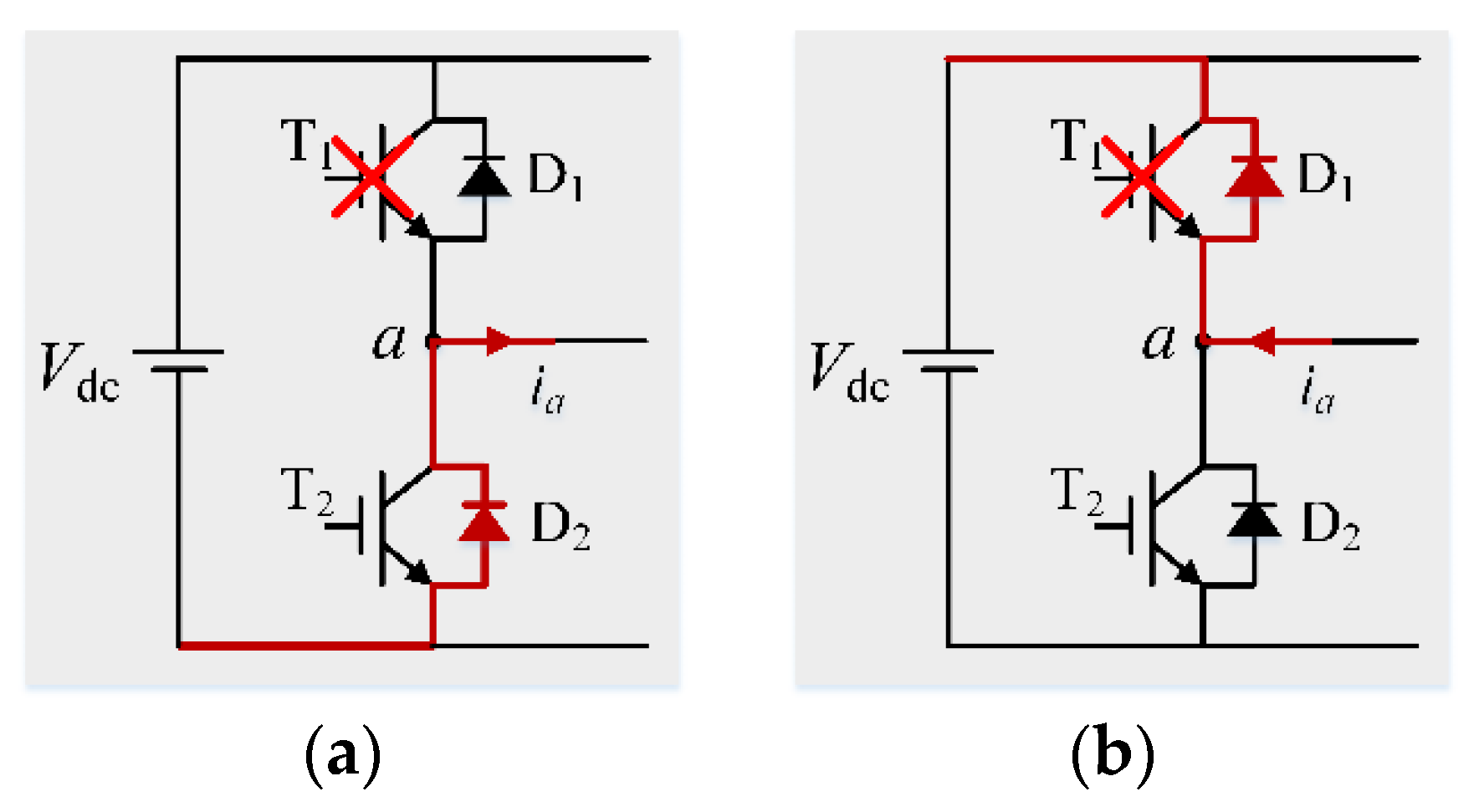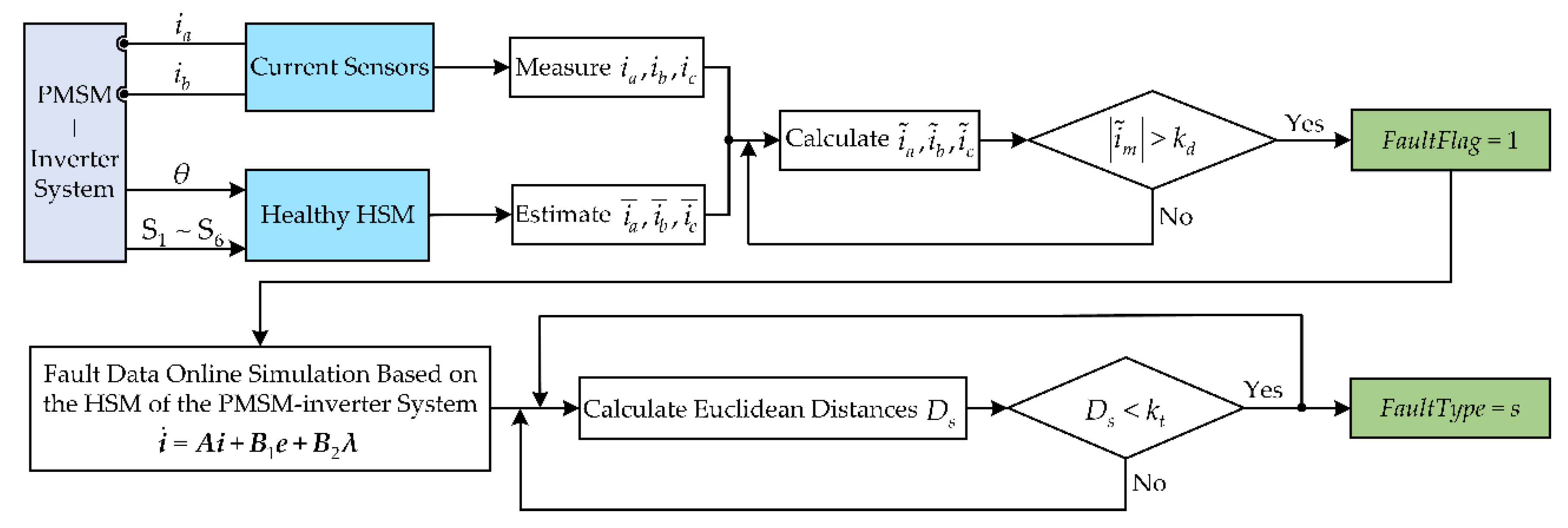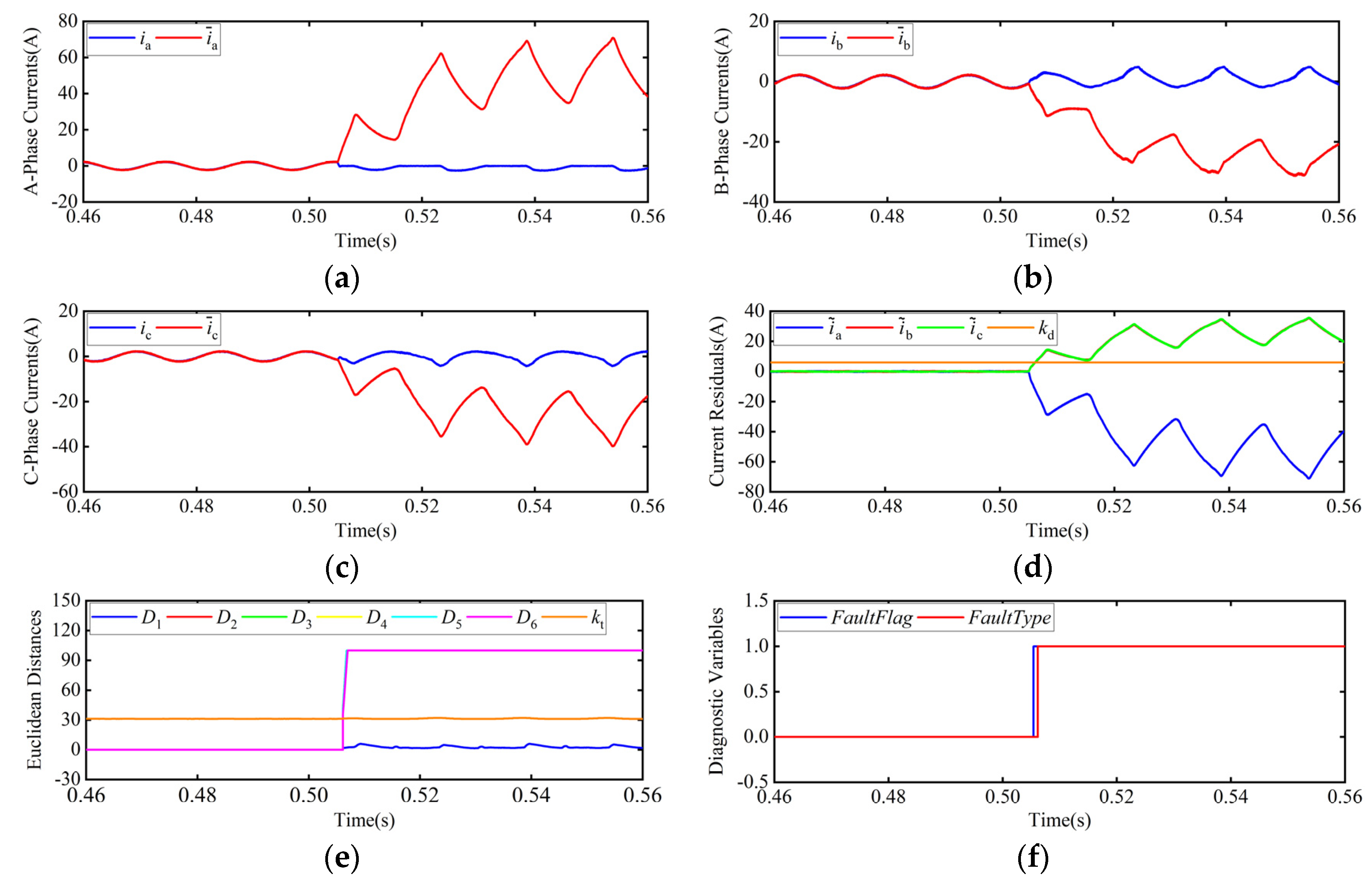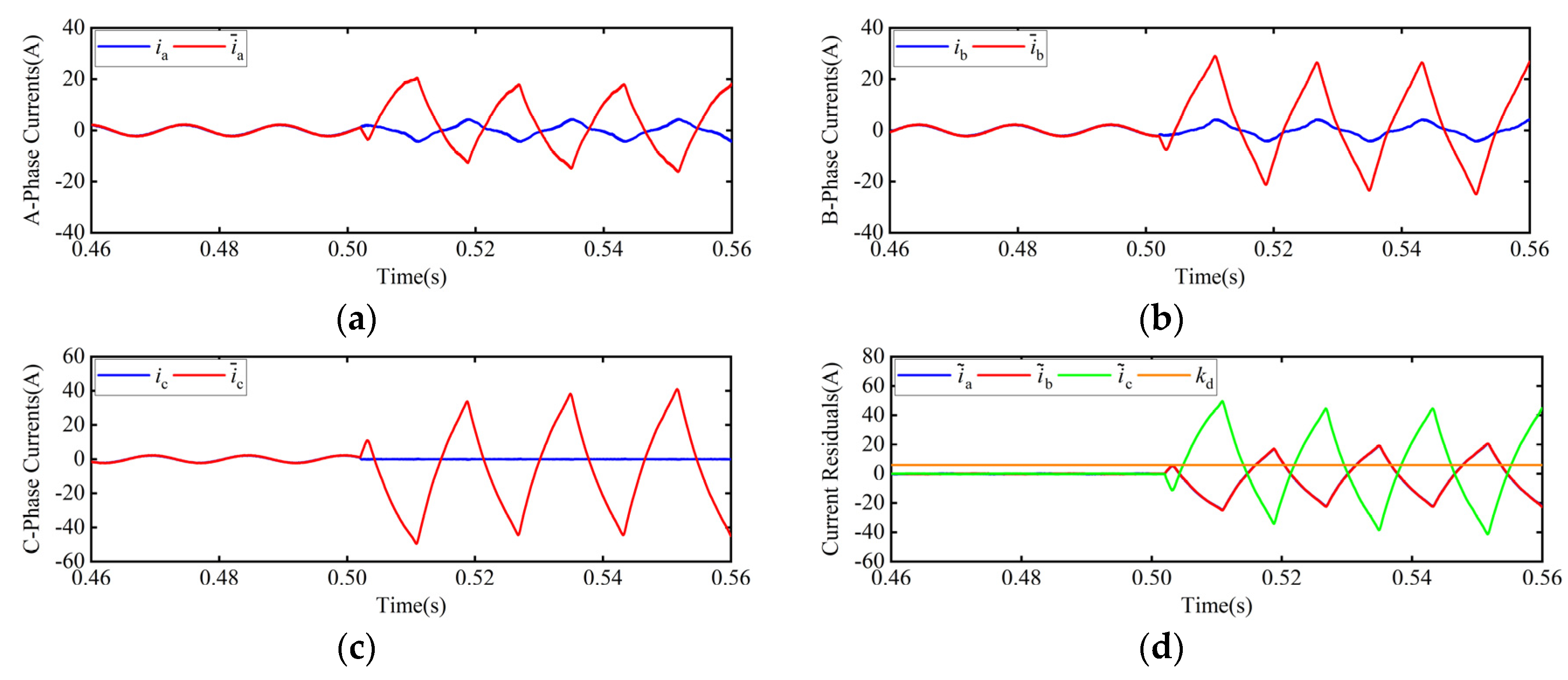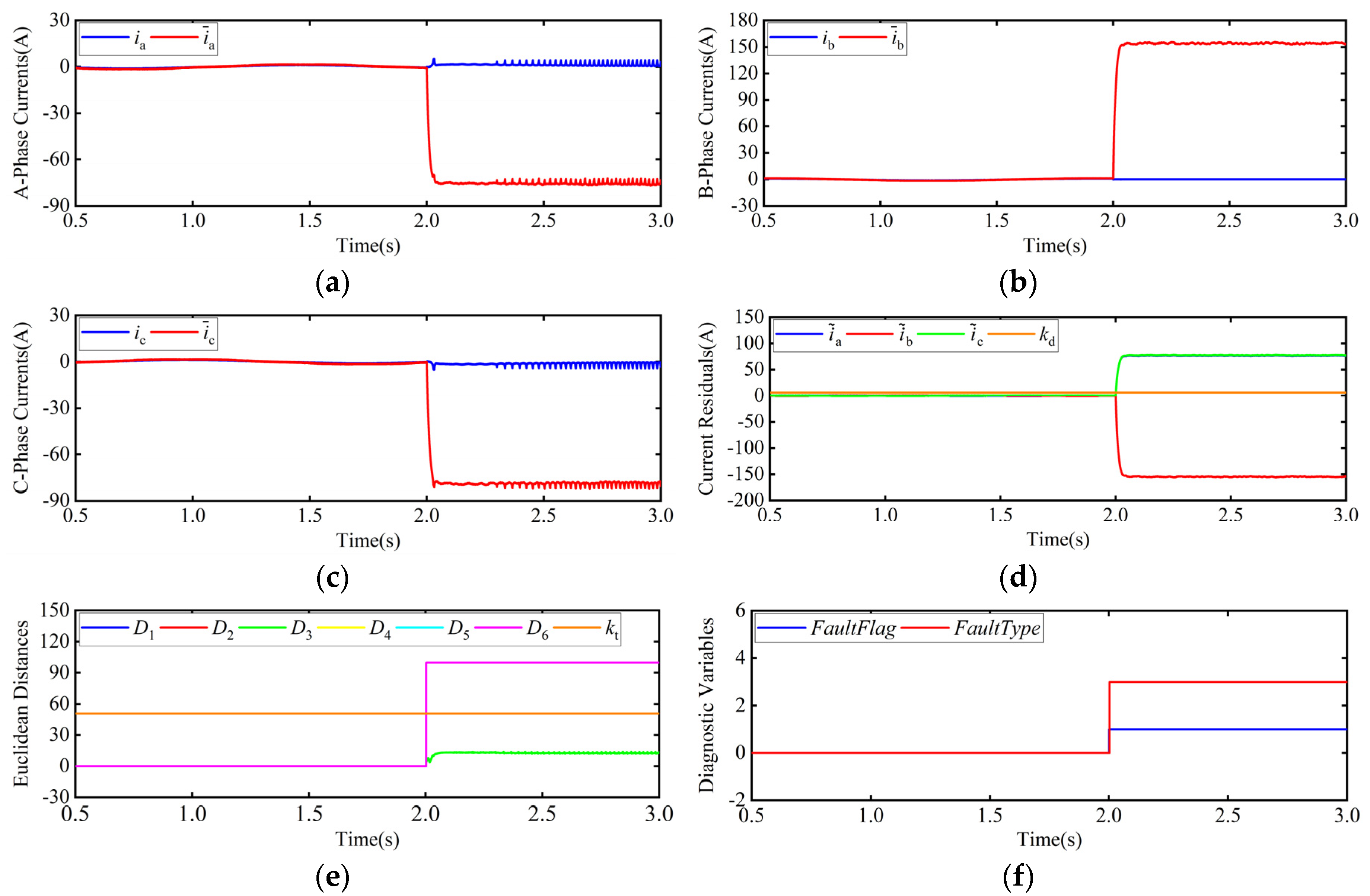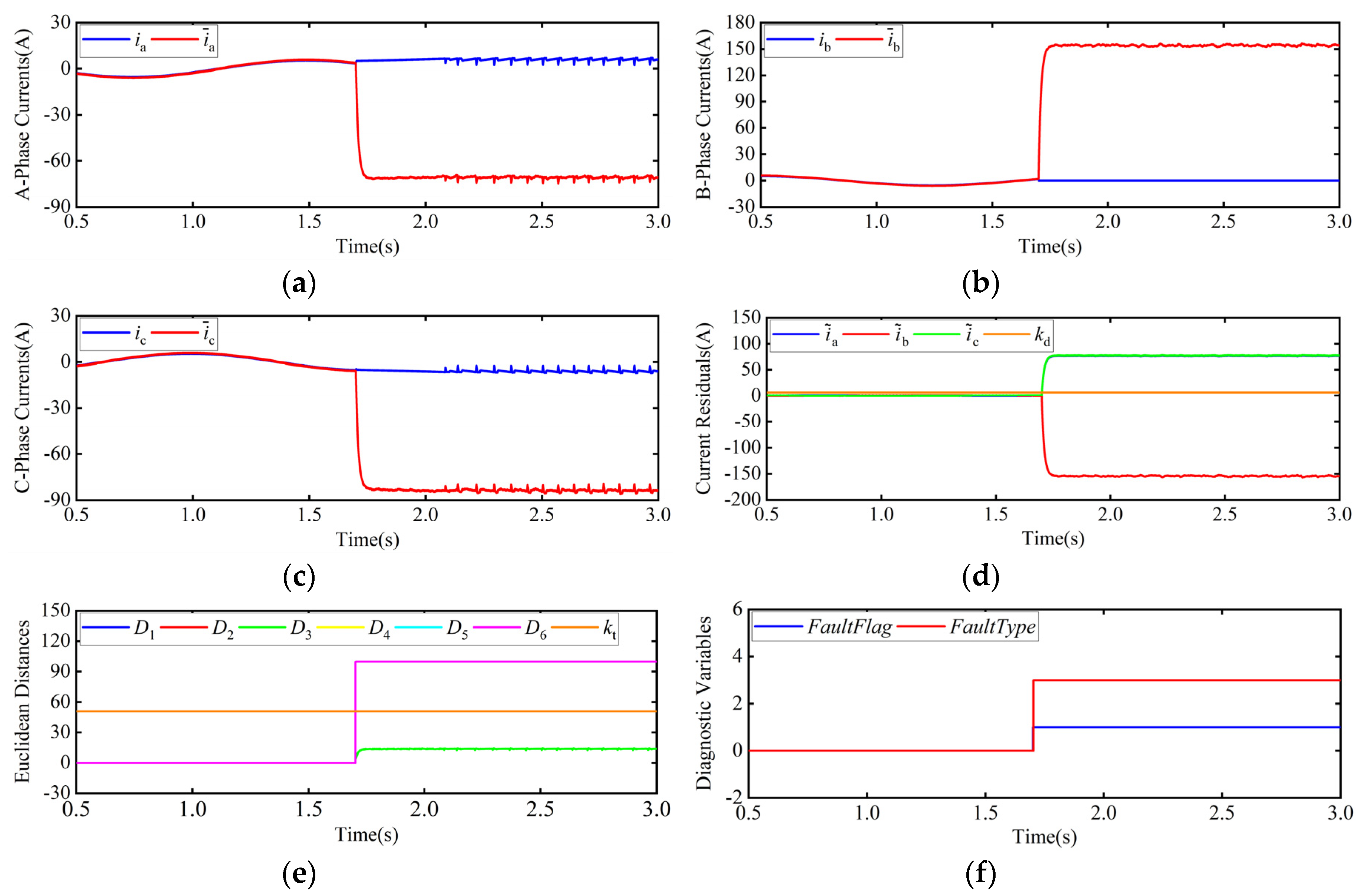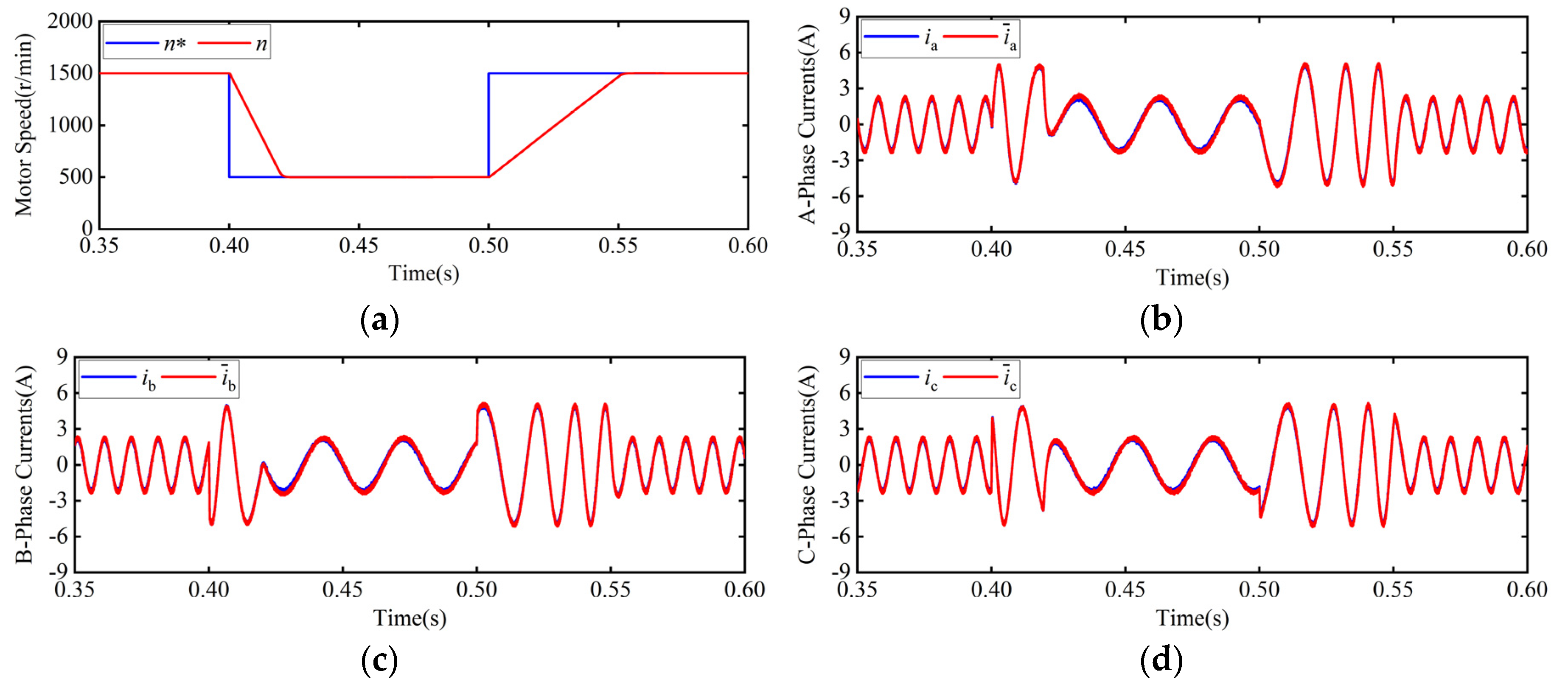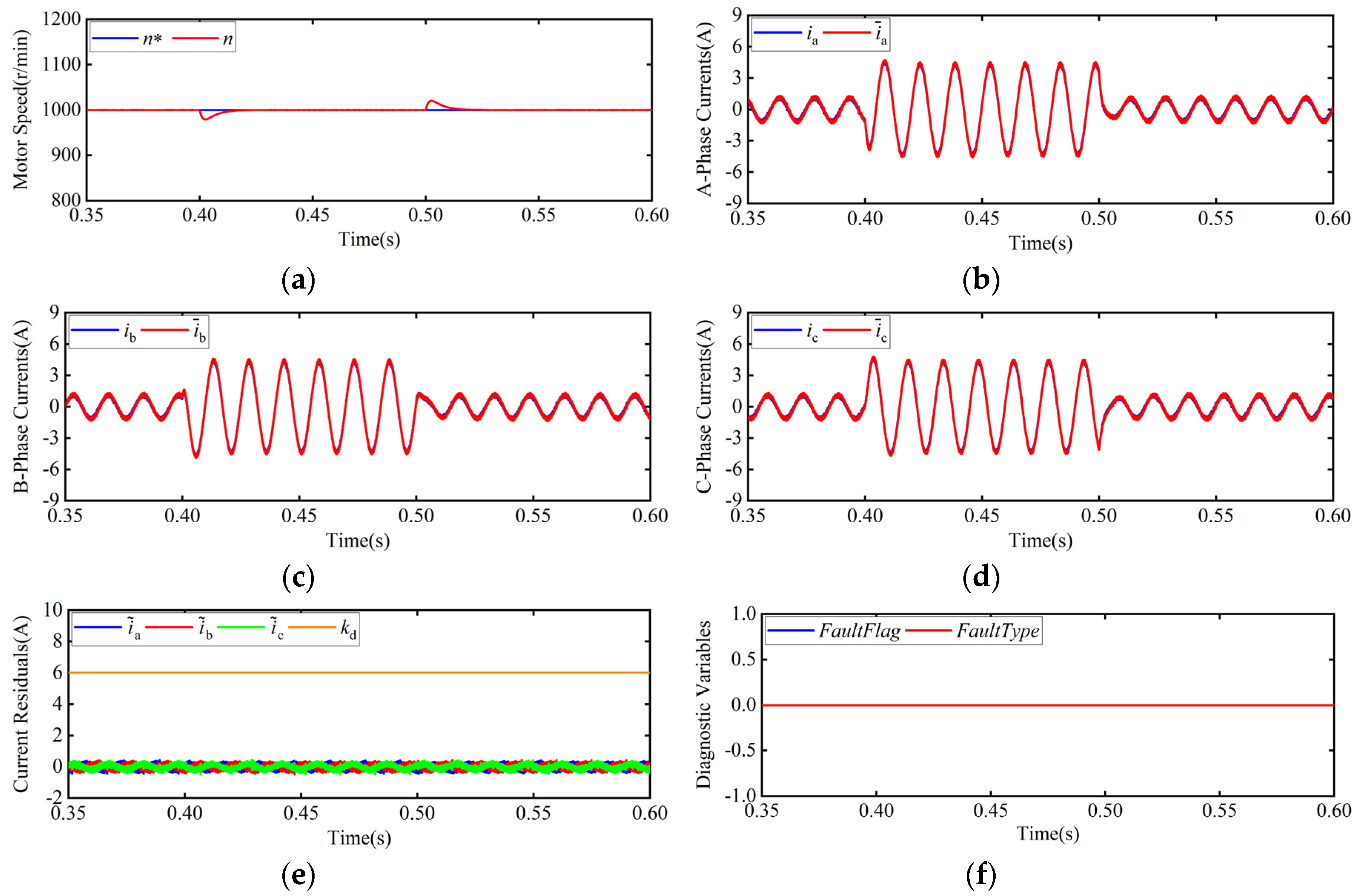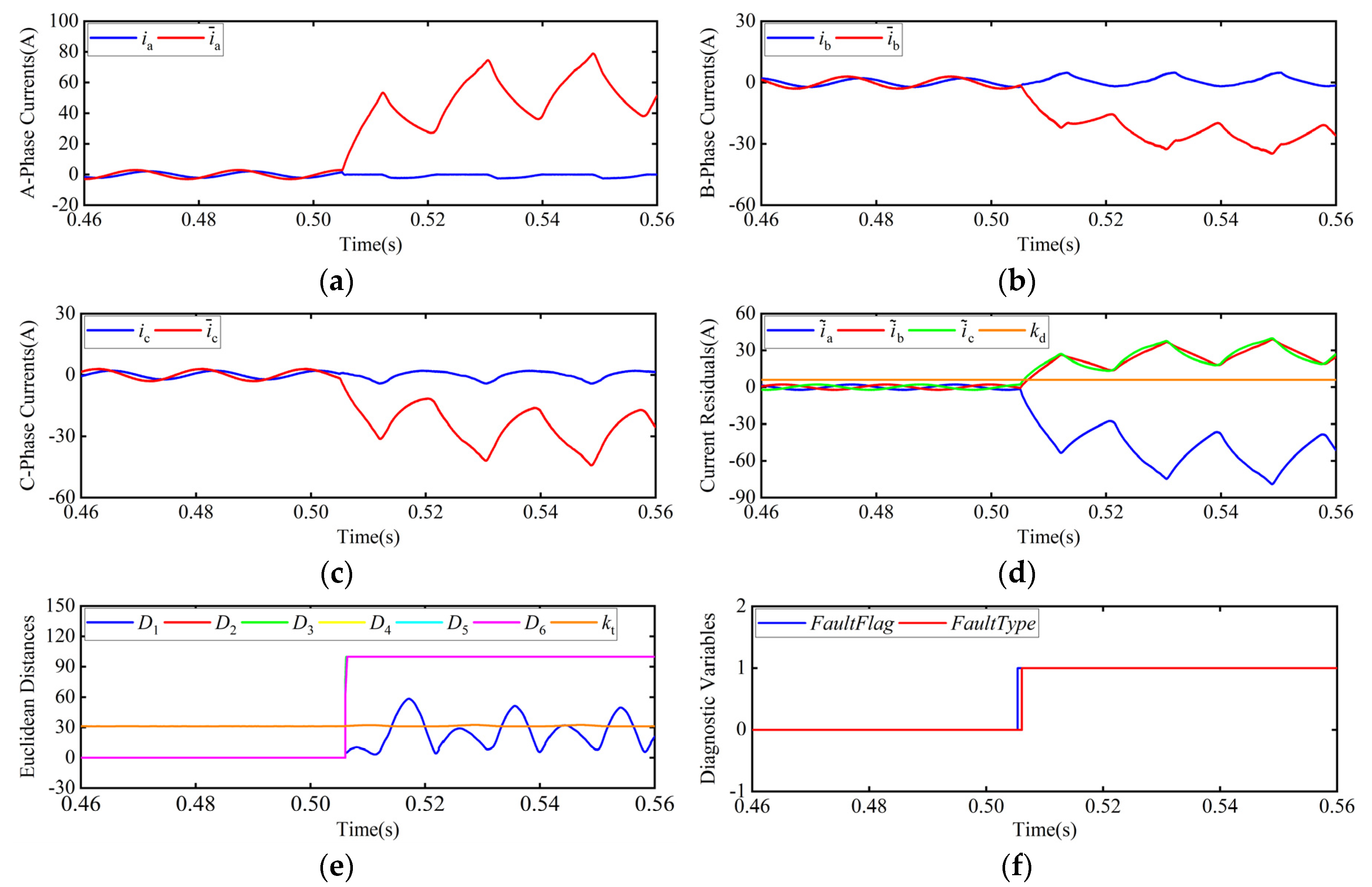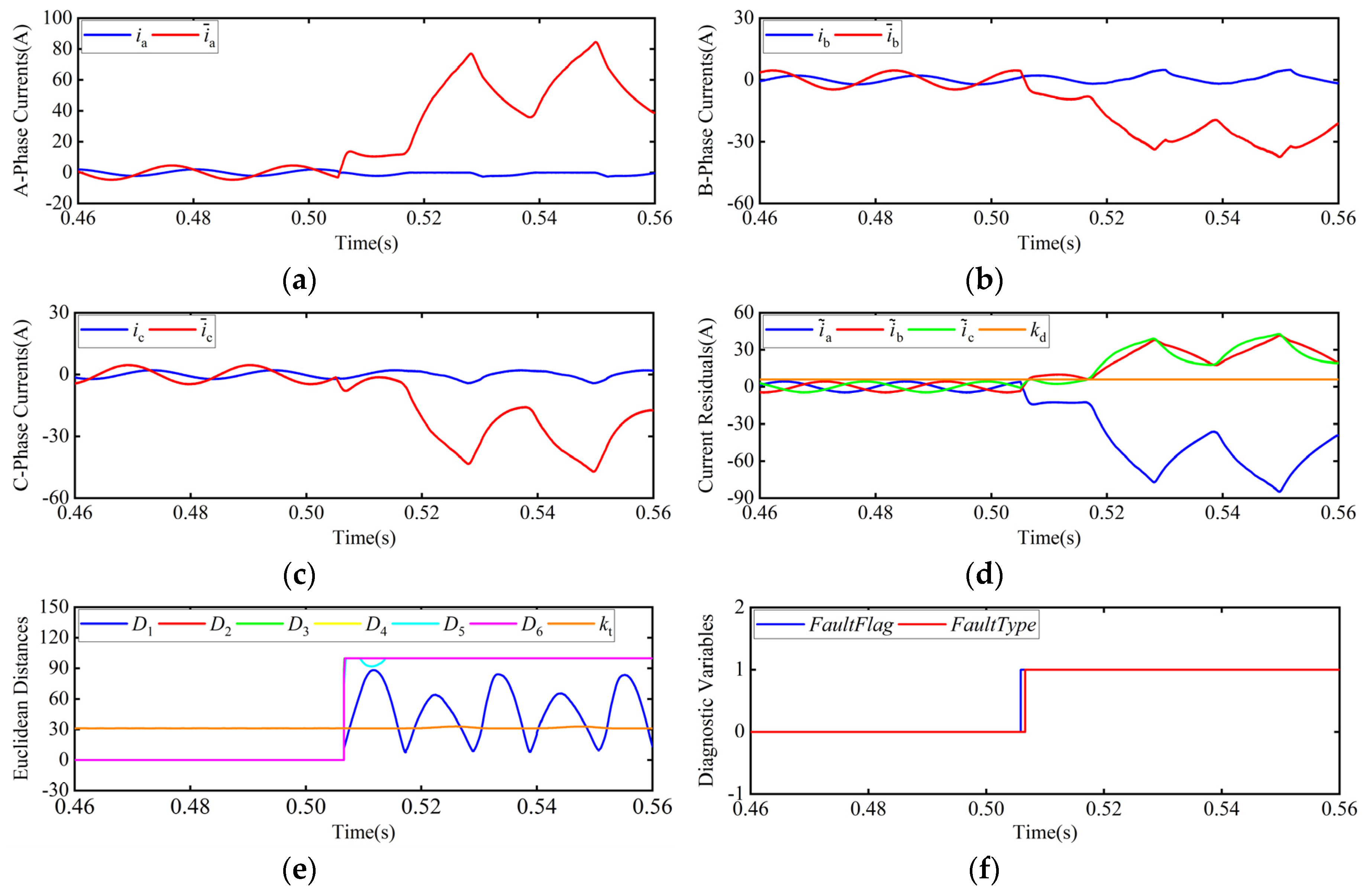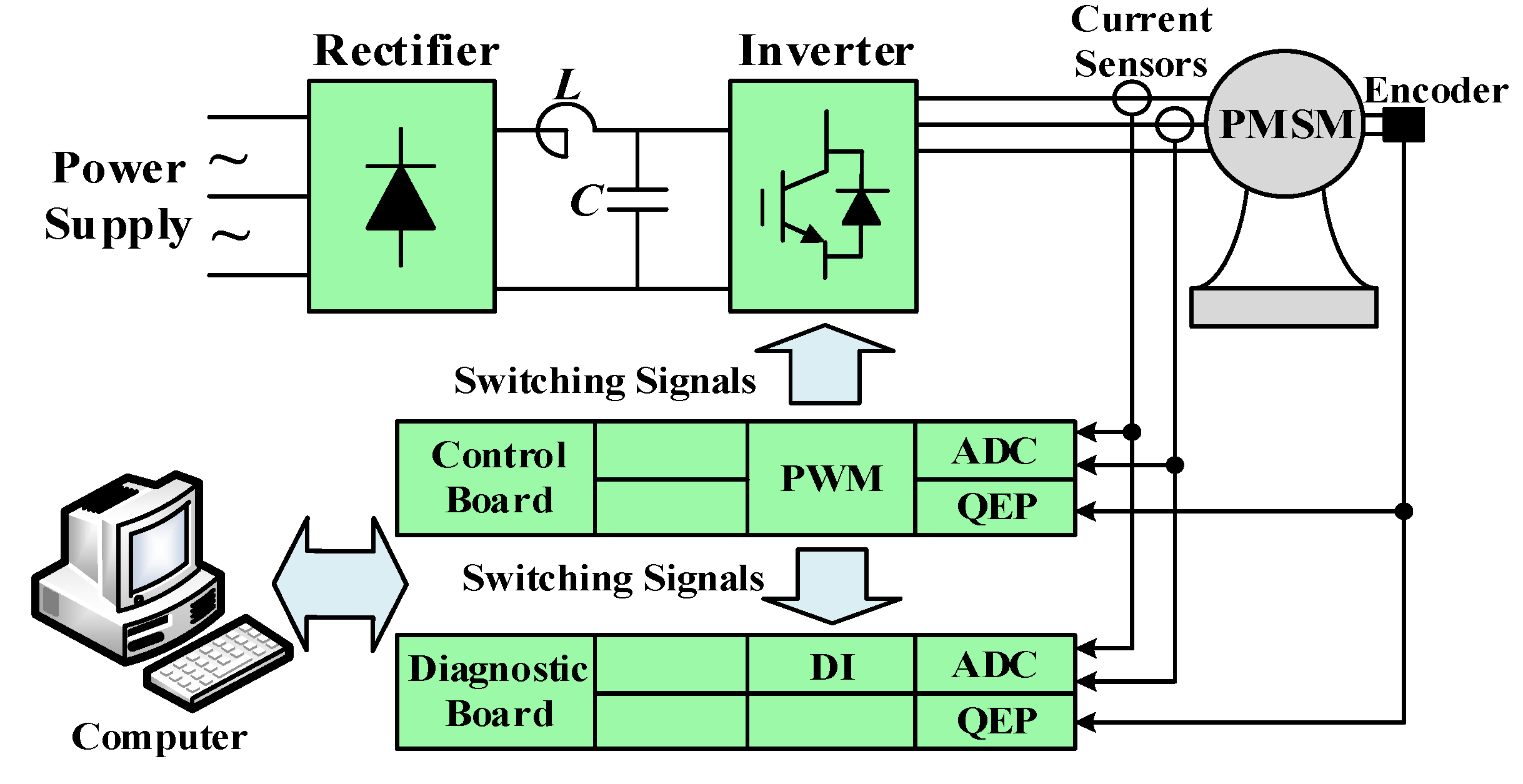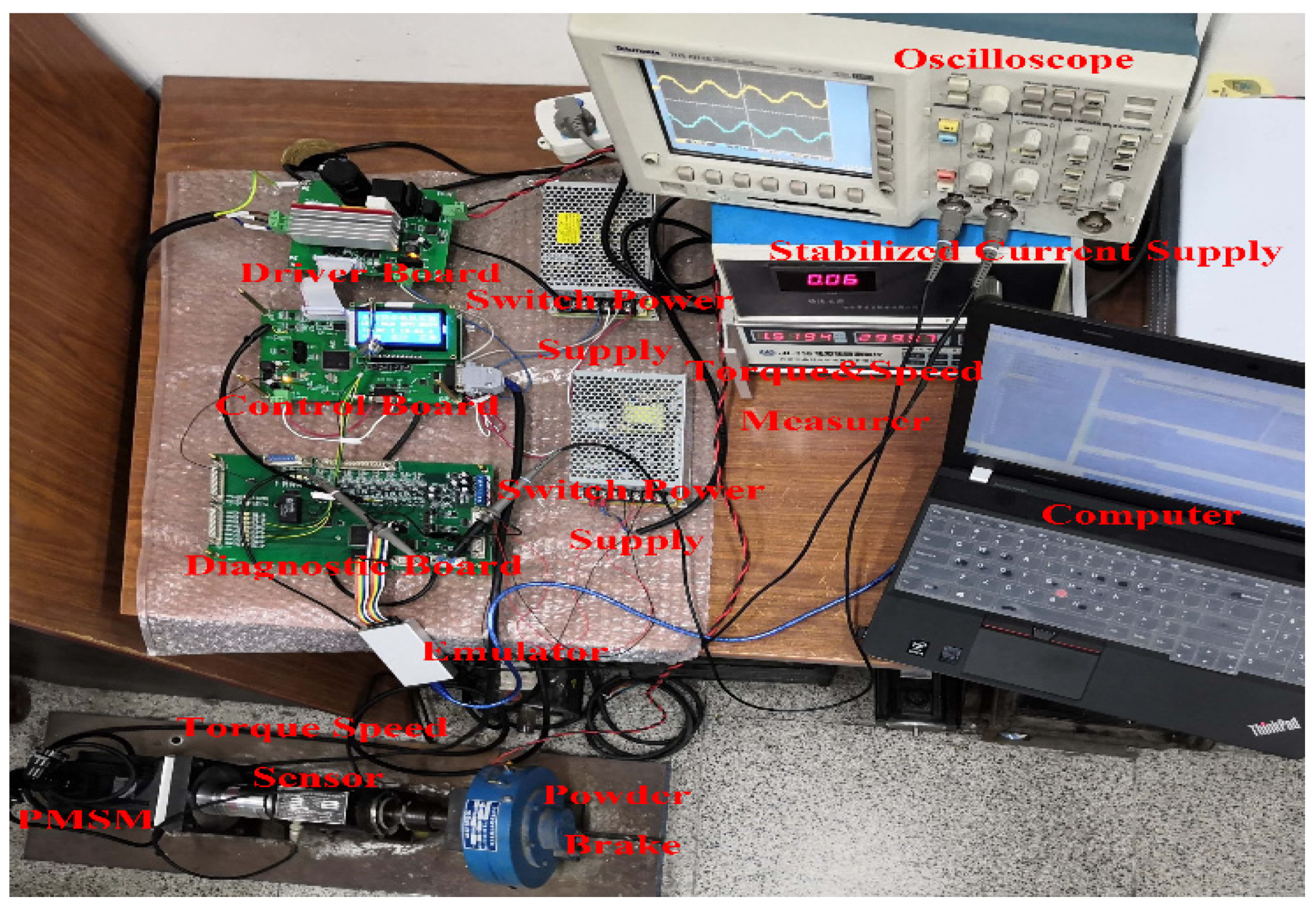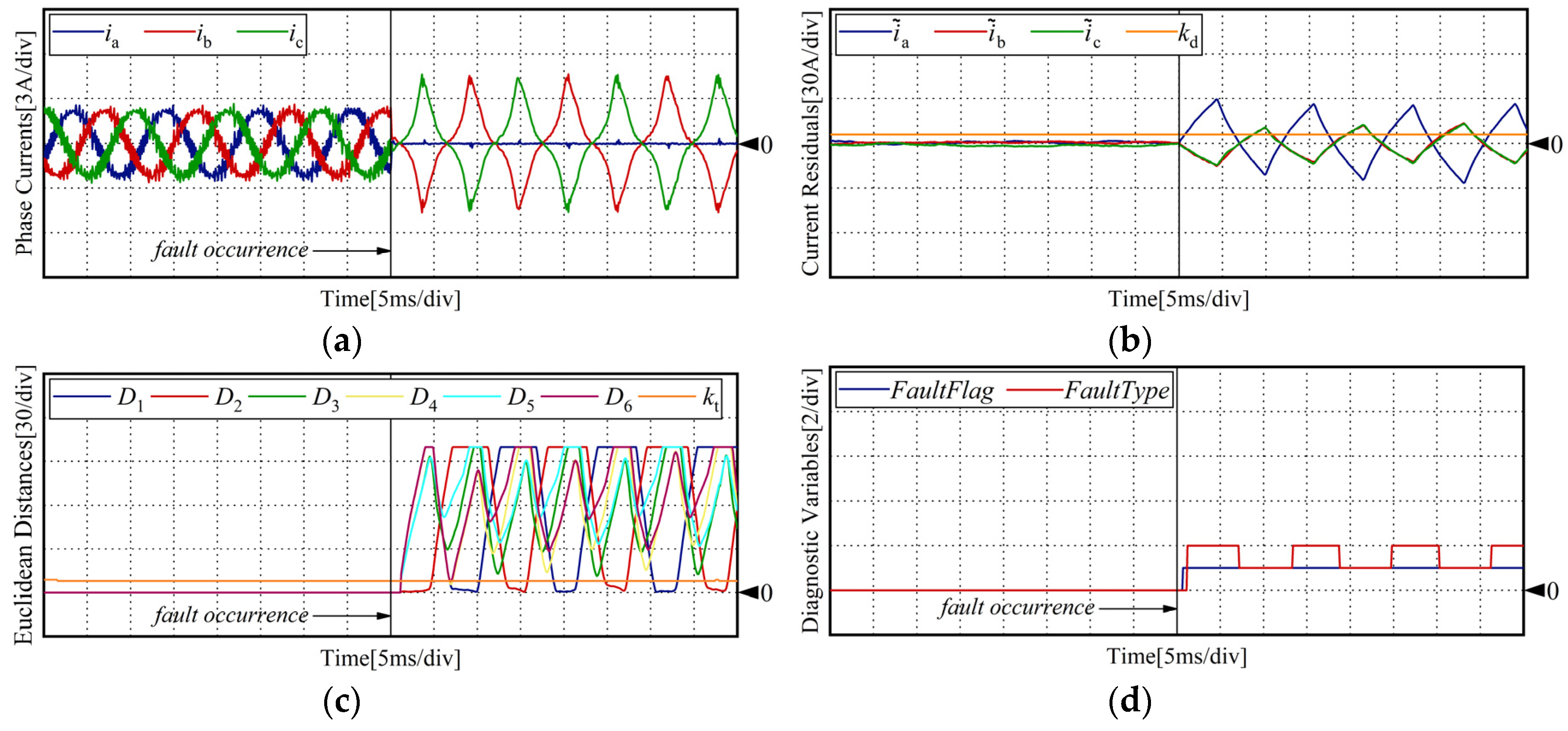1. Introduction
Voltage-source inverters (VSIs) have been extensively applied in power quality applications and motor drives due to their excellent performance of energy-saving and control. With the widespread application of VSIs, the safety and reliability of the inverter system have attracted more and more attention during the last years [
1,
2]. In the permanent magnet synchronous motor (PMSM) drive system, the semiconductor devices are considered as the most vulnerable part because they are often exposed to high stress and harsh environmental conditions. Therefore, numerous fault diagnosis methods of power devices have been proposed.
The faults of inverter power devices can be broadly classified as open-circuit (OC) faults and short-circuit (SC) faults. Due to the characteristics of its rapid occurrence and strong destructiveness, hardware protection circuits are generally designed to handle SC faults in the drive systems. The design methods of hardware protection circuits for SC faults are summarized in [
3]. Although OC faults are not as dangerous as SC faults, they may cause a secondary failure of the inverter or other drive components if they cannot be detected for an extended period of time, which would result in the total system shutdown and large economic losses [
4]. In order to prevent the spread of OC faults, many fault-tolerant control methods have been proposed [
5,
6,
7,
8,
9], but the premise of implementing these methods is the fast fault diagnosis.
According to whether the OC fault diagnosis methods are based on current or voltage measurement, they can be broadly classified into two categories: current-based and voltage-based methods. The current-based methods do not require additional sensors; they only need to use the current sensors existing in the closed-loop system to measure the currents for fault diagnosis. They have strong applicability and are widely used in practice. Therefore, various current-based diagnostic methods have been proposed, the most important of which are current-signal-based and current-observer-based methods. The current-signal-based methods may generate false alarms under the speed or load transient conditions of the motor drive system, and they take a long time to ensure high diagnostic accuracy. For example, the current vector trajectory analysis method is presented in [
10]; the authors analyzed the characteristics of the current vector trajectory under different fault conditions and used the slope of the current vector trajectory to describe fault characteristics. In Mendes and Marques [
11], the average current Park’s vector approach was proposed for diagnosing voltage-source inverter faults in variable-speed drive systems. The above two methods are simple in structure and easy to be implemented, but misdiagnosed results may be caused when the load currents are small. In order to get rid of effects of the load, the normalized current method was investigated in [
12,
13,
14]. In Sleszynski et al. [
12], the normalized current direct-current (DC) components method was introduced.In Zhang et al. [
13], the absolute value of the normalized currents and the current zero-cross detection approach were employed to avoid the influence caused by the transient condition. Bae et al. [
14] proposed an online fault identification method based on the average values of the normalized line-to-line currents for insulated gate bipolar transistor (IGBT) OC faults in three-phase pulse-width modulation (PWM) inverters. For current-observer-based methods, the residual signals between the measured outputs of the actual system and the estimated variables of the designed observer are used for fault diagnosis. For instance, in [
15], a class of non-linear proportional-integral observers was presented to identify the DC components of the fault profiles; then a directional residual evaluation was suggested for fault isolation.In Espinoza et al. [
2], a qualitative method based on a phasor representation of the residual vector was suggested for fault isolation in field-oriented control induction motor drives.In An et al. [
16], the current residual vector method was introduced to diagnose the fault according to the residuals between the estimated currents and the measured currents. The main drawback of current-observer-based methods is that the diagnosis performance depends on the accuracy of observer model parameters. However, due to its fast, real-time detection capability and the advantage of being easily embedded in existing control algorithms, it is still widely studied and applied. In recent years, some new current-based methods have been proposed. The zero voltage vector sampling method was proposed in [
17], which used a single dc-link current sensor to sample current during the two zero voltage vectors and reconstruct the three-phase currents, and then used the reconstructed three-phase currents to detect and locate the faulty power switch.In Wu and Zhao [
18], the allelic points and corresponding functions were proposed to describe the symmetry of the three-phase VSI topology under healthy and different OC fault conditions for fault detection and isolation. The diagnosis times of the above current-based methods are not less than a quarter of the current fundamental wave period, and some methods even exceed one current fundamental wave period.
As for voltage-based techniques, the diagnosis speed is generally faster than that of the current-based methods, but they often require additional voltage sensors or hardware in practical applications. A voltage model analysis method was proposed in [
19], which can detect and locate the faulty switch quickly by comparing the voltages measurements to their respective references. The fault diagnosis time of this method is within one-fourth of the current fundamental period, but additional voltage sensors are required to measure the inverter pole voltages, machine phase voltages, system line voltages or machine neutral point voltages.In Karimi et al. [
20], a fast fault detection method based on the field-programmable gate array (FPGA) was introduced. The method can detect a faulty switch or driver in less than 10 μs, but it has complex hardware and high cost.In Choi and Lee [
21], a voltage measurement-based sectoral diagnosis method was described for OC faults of inverter-fed PMSM drives. The proposed method used a separate residual for each switch as a sectoral average to improve the robustness of the fault diagnosis algorithm. In order to simplify the fault diagnosis circuit and avoid additional sensors, an indirect voltage measurement method using high-speed photocouplers was presented in [
22].In Jung et al. [
23], the fault diagnosis was achieved by a model reference adaptive system-based voltage distortion observer. The diagnosis speeds of the above three voltage-based methods are high and the fault diagnosis can be completed within 1 ms.
Some data-driven methods are also applied to OC fault diagnosis of inverters, such as neural networks [
24,
25,
26], Bayesian networks [
27], fuzzy logic [
28,
29], wavelet analysis [
30], support vector machines [
31] and machine learning [
32]. However, these methods are difficult to be implemented due to the complex algorithms and large amounts of calculations, plus the diagnosis time is generally longer than one current fundamental wave period.
In this paper, a fast online fault diagnosis method is proposed for OC faults of three-phase voltage-source inverters in PMSM drive systems. The hybrid system model (HSM) of the PMSM-inverter system is established by analyzing the three-phase voltages under healthy conditions and different fault conditions. In order to reduce the amount of calculating during normal operations, a state estimator is constructed by using the healthy HSM to determine whether the fault occurs. In the process of fault isolation, the HSM is used to generate fault data of different fault types online, and then the fault type which is most similar to the actual one is found based on the Euclidean distance method, so as to achieve fault diagnosis. The proposed method has the features of avoiding the use of extra sensors, robustness against false alarms and fast diagnosis time, and can complete fault diagnosis within one-tenth of the current fundamental wave period. The rest of the paper is organized as follows: firstly, the HSM of the PMSM-inverter system is established in
Section 2; secondly, the proposal for fault detection and isolation is detailed in
Section 3; thirdly,
Section 4 and
Section 5 describe the simulation and experimental results; and finally,
Section 6 presents the conclusion.
5. Experimental Results
To verify the effectiveness of the proposed method, the experimental validation was implemented based on two digital signal processing (DSP) boards, and the scheme and photograph of the experiment platform are shown in
Figure 12 and
Figure 13, respectively. One DSP board (TMS320F28335) was used to control the motor, and the other (TMS320F2812) was used to diagnose the fault. The dc-bus voltage was 311 V, and the switching frequency was 5 kHz with a dead time of 2.67 μs. The sampling rate used for fault diagnosis was 10 kHz, and the one-step Euler method was used in the discrete time realization of the fault data online simulation with a sampling period of 50 μs. In experiments, the data were saved in the flash memory of the diagnostic board and transmitted to the PC after the motor stopped. All the data could be saved as CSV files for redrawing, and the following figures in experimental parts were obtained in this way. The motor parameters and the threshold values are the same as those of the simulation conditions, and the Euclidean distances are also limited to 100 for ease of display. For the convenience of the experiment, the OC faults are simulated by setting the gate drive signals of the power switches to null.
The time-domain waveforms of the motor phase currents together with the Euclidean distances and diagnostic variables for the OC fault by considering a reference speed of 800 r/min with 2 N·m load are shown in
Figure 14 and
Figure 15.
Figure 14 shows the performance of the fault detection and isolation in the case of a lower switch OC fault; the fault occurred in the switch T
2.
Figure 15 shows the performance in the case of a phase OC fault in leg B. From these experimental results, the Euclidean distances and the fault output variables were all equal to zero under healthy conditions. When an OC fault occurred in the inverter, the motor three-phase currents were no longer sinusoidal and balanced, and the fault flag variable
changed to 1. As a result, the Euclidean distances began to change; each time at most one Euclidean distance was less than the preset threshold, and other Euclidean distances were far greater than the threshold, so the faulty switch can be isolated. Regarding the fault diagnosis time in the experiment, the obtained results show that the inverter’s abnormal operation was detected within 0.7 ms after the OC fault occurrence, which is about 3.73% of the current fundamental wave period, and the faulty switch can be correctly isolated in 1.50 ms, which is 8% of the current fundamental wave period.
Figure 16 and
Figure 17 show the time-domain waveforms of the motor phase currents together with the Euclidean distances and diagnostic variables for the OC fault by considering a reference speed of 1400 r/min with 2 N·m load.
Figure 16 shows the test results for an upper switch OC fault; the fault occurred in the switch T
5.
Figure 17 shows that in the case of a phase OC fault in the leg A. Similarly to the previous cases, under normal operating conditions, the Euclidean distances and the fault output variables wer all equal to zero values, and the faulty switch could be quickly detected and isolated by the proposed algorithm after an OC fault occurred. In this case, the fault detection time was about 0.5 ms, which is about 4.67% of the current fundamental wave period, and the isolation time was about 1.1 ms, which is about 10.27% of the current fundamental wave period.
The comparison of the proposed method and previous current-based methods is summarized in
Table 7 in terms of diagnosis time, robustness (independence to transient disturbance, such as load fluctuation and variable speed), tuning effort (whether the threshold values are easy to select) and fault type (single fault, double fault or both). In this table,
is defined to represent a current fundamental wave period. As can be seen in this table, compared with the previous current-based methods, the diagnosis speed is greatly improved.

